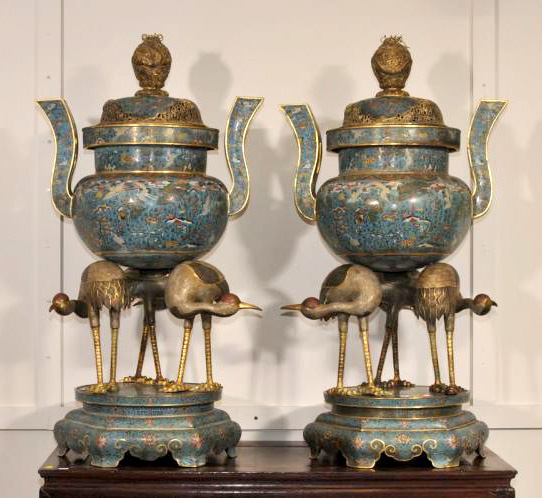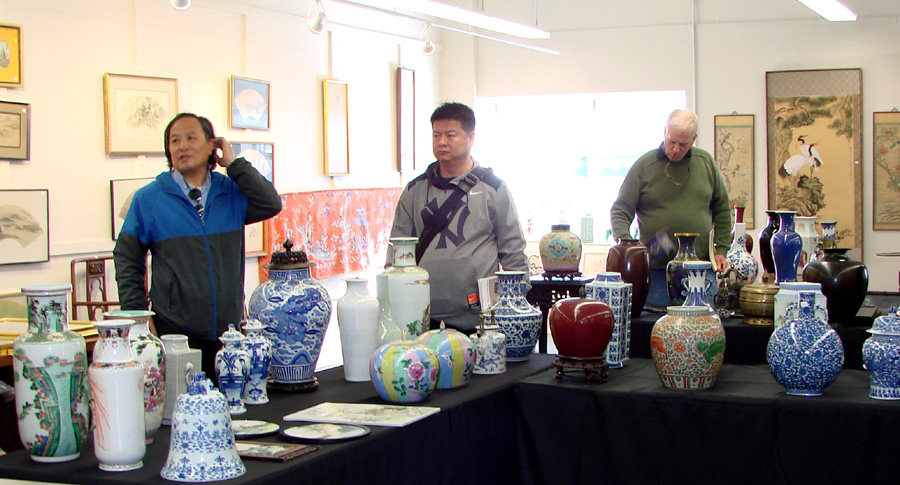Review By Rick Russack,
Catalog Photos Courtesy Tremont Auctions
NEWTON, MASS. — Tremont Auctions is one of Boston’s newest auctioneers and it held its first sale of Asian arts March 19–20. The sale was under the direction of vice president Jim Callahan, a well-known authority on Asian arts, having worked with other New England auctioneers and who often appears on Antiques Roadshow.

Doug Stinson, president of Tremont Auctions, and vice president Jim Callahan, who organized the sale, stand with a carved blackwood cabinet.
An active crowd filled the salesroom, competing against numerous left bids, several phone lines and the Internet and often prices far exceeded estimates. The top lot of the weekend was a large pair of Chinese cloisonné incense burners that brought $111,150.

The top lot of the weekend sale was this large pair of Chinese cloisonné incense burners. Standing 44 inches tall, on feet in the form of cranes, it was decorated with symbols of longevity — cranes, deer and pine trees. The pair realized $111,150.
The market was strong for Chinese export silver, porcelains, jade and a fine collection of Japanese sword fittings, while a carved rhinoceros horn libation cup brought the second highest price of the sale. It far exceeded its conservative high estimate of $8,000 to achieve $51,480.
To assist buyers, Tremont had two translators on hand to facilitate phone discussions with Asian bidders. Only 45 of the sale’s 769 lots had reserves. The two-day sale grossed $840,000, well over the high estimates of about $500,000. Callahan said, “We’re really pleased with the sale. We had the right buyers, and we’re seeing more and more of the bidding being done on the Internet. Asian buyers in particular, I think, like the anonymity that online bidding gives them.”
The first day got off to a good start with amber and jade jewelry and a collection of Japanese sword fittings. A vintage 25-inch amber necklace with graduated butterscotch beads set the tone of the day, finishing at $2,574, five times over estimate. A Chinese gold and pearl mounted apple-green jadeite pin in the form of a butterfly sold for $1,521 to a dealer in the room. A pair of Art Deco-style earrings, with pierced Chinese green jadeite drops, mounted in white gold or platinum, went to an absentee bidder for $1,404.
The collection of Japanese sword fittings had been assembled in the 1930s by a doctor in Wisconsin who had traded his services for the sword fittings. Most were sold in pairs that included both the fuchi and kashira fittings. Fuchi refers to the hilt collar and the kashira is the butt cap, or pommel, on the end of the sword. A pair dating to the Eighteenth Century, copper with mixed metal inlays of gold shakuda and shibuichi, realized $1,521. A signed pair that was cataloged as Eighteenth or Nineteenth Century, having inlays of shakudo and gold with designs of shishi, finished at $1,117. Other pairs sold between $235 and $819.

The second highest price of the sale was achieved by a carved rhinoceros horn libation cup, which earned $51,480. Perhaps dating to the Eighteenth Century, with a great patina, it was finely carved with scholars in a mountain landscape with a river, bridges and pine trees.
The large Chinese cloisonné incense burners that were the sale’s top lot came from a New York collector. They were 44 by 24 inches, standing on feet in the form of cranes, with heavenly soaring handles, and they were decorated with cranes, deer and pine trees — Chinese symbols of longevity. The bases were stylized lions. They bore Ch’ien Lung marks. Ch’ien Lung (1711–1799) was the sixth emperor of the Qing dynasty and ruled for more than 60 years. Other Chinese cloisonné also did well. A vase in the form of a pilgrim flask, with Ju-i handles and repousse-gilt dragons, cataloged as Nineteenth or Twentieth Century, had a four-character Ch’ien Lung mark engraved on the base. It was estimated at $500 but reached $3,744. A 12½-inch pair of Nineteenth Century censers, with fang ting-form decoration of the eight precious emblems on a turquoise ground, also went well over the estimate, earning $4,680.
Several fine pieces of porcelain brought prices in excess of their estimates. An exquisite Japanese Yabu Meizan Satsuma covered urn reached $21,600, going to a phone bidder. It was 101⁄8 inches tall with an allover finely decorated landscape with floral decoration. Meizan’s studio operated from the 1880s to the 1920s and this piece was marked with his gilt seal. Dating to 1821–50, a Chinese wu tsai dragon decorated porcelain bowl, 6¼ inches wide, achieved $11,700.
Bringing 21 times its estimate was a 24-inch porcelain vase with animal-form handles in iron red and gilt, and a continuous famille rose landscape, which went out at $10,500. It had a Ch’ia Ching mark. Also doing well was a pair of Chinese blue and white vases, cataloged as having a Kuang Hsu mark and probably of the period, decorated with acanthus leaves and floral scrolling, which sold for $9,360, in spite of repairs to both vases. A Chinese carved porcelain vase, Eighteenth or Nineteenth Century, with underglaze blue, red and celadon dragon decoration, earned $3,042.

Josh Chamberlain, Amherst, N.H., dealer, examines one of the many pieces of Chinese porcelain in the sale. Asian porcelain and arts are one of his specialties.
A group of Chinese export silver, assembled from various collections, showed the strength of that market. A very unusual lobed bowl with enameled bird, floral and bamboo decoration brought $17,550. It was 7½ inches wide and marked “China Silver.” A Nineteenth Century three-piece tea set with raised bamboo and insect decoration, finished at $4,212, and a Nineteenth Century silver vase on three dragon feet went for $2,223. It had nine panels with landscape and floral decorations. Another lobed bowl, this one with six panels of landscapes, dragons and bamboo against a stippled background, reached $2,106. It was marked “M.K.” and had a Chinese signature on the base. A Nineteenth Century Anglo-Indian silver bowl with repoussé scenes of a tiger hunt, elephants, peacocks farmers and angels made a final price of $2,106. Callahan told Antiques and The Arts Weekly that some of the silver prices were surprises — both high and low.
In addition to the jade jewelry mentioned earlier, there was a wide assortment of carved jade and jadeite. A carved lavender jadeite vase had carved elephant handles and was covered with mythical phoenix and floral carving. At 10¾ inches tall, it sold for $12,870. A chicken-blood jade table screen with black veining, deeply carved with a scholar and attendant in a mountain landscape, went for $5,850. It had a ten-character inscription referring to the immortals. Finishing at just a few dollars less was a pale green-white jade covered vase, carved with figures in a landscape and dragons. It brought $5,265. A 3-inch grey-white jade pendant, carved with five archaic characters on a wave ground with brocade borders, earned $4,446.

From the studio of Yabu Meizan, (1853–1934) this exceptional Japanese Satsuma covered urn brought $21,060 from a phone bidder. It was decorated with a finely executed landscape scene with floral decoration and signed with a gilt seal.
The aforementioned libation cup, Seventeenth–Eighteenth Century, was finely carved with scholars in a mountain landscape with a river, bridges and pine trees, 4½ by 6 inches, and it had a finely polished patina due to centuries of handling. Also worth noting were several pieces of Chinese furniture, including an altar table, 64 inches long, from the Kuang Hsu period, 1875–1908. The aprons were carved with dragons, and clouds inset with repoussé brass plaques. On cabriole legs, it sold for under estimate for $5,265, while a carved blackwood cabinet, with allover carved and pierced floral decoration, went out for $2,233, also under estimate. There were several scrolls and paintings. An embroidered silk scroll depicting a landscape with birds, probably Eighteenth–Nineteenth Century, fetched $9,360, and a hand scroll for an official promotion, dated Kang His, 6th year, (1668), written in Chinese and Manchu, realized $9,945.
After the sale, Josh Chamberlain, an Amherst, N.H., dealer, who specializes in Asian material, told Antiques and The Arts Weekly that he thought the overall results were strong. “They really did well across the board. Just about everything brought what it should have and I don’t think anything slipped through. It looked like about two-thirds of the stuff went to Internet bidders — that can be tough competition for dealers.” When asked about the prices of the export silver, Chamberlain said, “That market has strengthened in recent years as mainland Chinese buyers started to collect. Even though it was made for export, it has gained interest and the prices now reflect that interest.”
All prices reported include the buyer’s premium.
For additional information, www.tremontauctions.com or 617-795-1678.





